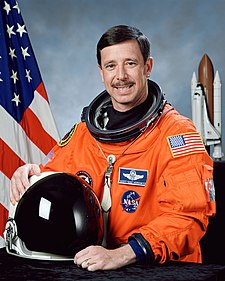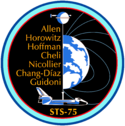Scott Horowitz
| Scott Horowitz | |
|---|---|
 Scott Horowitz, 2001 | |
| Astronaut NASA | |
| Státní příslušnost | americká |
| Datum narození | 24. března 1957 (66 let) |
| Místo narození | Filadelfie, Pensylvánie |
| Předchozí zaměstnání | zkušební pilot |
| Hodnost | plukovník, USAF |
| Čas ve vesmíru | 47 dní, 10 hodin a 41 minut |
| Mise | STS-75, STS-82, STS-101, STS-105 |
| Znaky misí | |
| Některá data mohou pocházet z datové položky. | |
Scott Jay „Doc“ Horowitz (* 24. března 1957 Filadelfie, Pensylvánie) je bývalý americký astronaut, plukovník amerického letectva a veterán vesmírných misí.
Studoval inženýrství na California State University a poté získal doktorát z leteckého inženýrství na Georgia Institute of Technology (1982) a pracoval jako vědec pro Lockheed Company. Později vstoupil do amerického letectva a létal na strojích T-38 a F-15. V prosinci 1990 úspěšně absolvoval United States Air Force Test Pilot School. V roce 1992 byl vybrán NASA jako kandidát na astronauta. Později pilotoval mise STS-75 (1996), STS-82 (1997) a STS-101 (2000). Velel misi STS-105 na Mezinárodní vesmírnou stanici (ISS), během které došlo k doplnění zásob a výměně posádky stanice.
Odkazy
Reference
V tomto článku byl použit překlad textu z článku Scott J. Horowitz na anglické Wikipedii.
Externí odkazy
 Obrázky, zvuky či videa k tématu Scott Horowitz na Wikimedia Commons
Obrázky, zvuky či videa k tématu Scott Horowitz na Wikimedia Commons - (anglicky) NASA – Scott Horowitz: Biografie
Média použitá na této stránce
Astronaut Scott J. Horowitz
The STS-101 mission patch commemorates the third Space Shuttle flight supporting the assembly of the International Space Station (ISS). This flight's primary tasks are to outfit the ISS and extend its lifetime, and to conduct a spacewalk to install external components in preparation for the docking of the Russian Service Module, Zvezda, and the arrival of the first ISS crew. The Space Shuttle is depicted in an orbit configuration prior to docking with the ISS. The ISS is depicted in the stage of assembly completed for the STS-101 mission, which consists of the United States-built Unity module and the Russian-built Zarya module. The three large stars represent the third ISS mission in the assembly sequence. The elements and colors of the border reflect the flags of the nations represented by the STS-101 crew members, the United States and Russia. The NASA insignia design for Shuttle flights is reserved for use by the astronauts and for other official use as the NASA Administrator may authorize. Public availability has been approved only in the form of illustrations by the various news media. When and if there is any change in this policy, which is not anticipated, it will be publicly announced.
The STS-105 crew patch symbolizes the exchange of the Expedition Two and Expedition Three crews aboard the International Space Station. The three gold stars near the ascending Orbiter represent the U.S. commanded Expedition Three crew as they journey into space, while the two gold stars near the descending Orbiter represent the Russian commanded Expedition Two crew and their return to Earth. The plumes of each Orbiter represent the flags of the United States and Russia and symbolize the close cooperation between the two countries. The Astronaut Office symbol, a star with three rays of light, depicts the unbroken link between Earth and the newest and brightest star on the horizon, the International Space Station (ISS). The ascending and descending Orbiters form a circle that represents both the crew rotation and the continuous presence in space aboard the ISS. The names of the four astronauts who will crew Discovery are shown along the border of the patch. The names of the Expedition Three and Expedition Two crews are shown on the chevron at the bottom of the patch. The NASA insignia design for Shuttle flights is reserved for use by the astronauts and for other official use as the NASA Administrator may authorize. Public availability has been approved only in the form of illustrations by the various news media. When and if there is any change in this policy, which we do not anticipate, it will be publicly announced.
STS-82 Mission Insignia
- STS-82 is the second mission to service the Hubble Space Telescope (HST). The central feature of the patch is HST as the crew members will see it through Discovery's overhead windows when the orbiter approaches for rendezvous, retrieval and a subsequent series of spacewalks to perform servicing tasks. The telescope is pointing toward deep space, observing the cosmos. The spiral galaxy symbolizes one of HST's important scientific missions, to accurately determine the cosmic distance scale. To the right of the telescope is a cross-like structure known as a gravitational lens, one of the numerous fundamental discoveries made using HST Imagery. The names of the STS-82 crew members are arranged around the perimeter of the patch with the extravehicular activity's (EVA) participating crew members placed in the upper semicircle and the orbiter crew in the lower one.
STS-75 Mission Insignia





